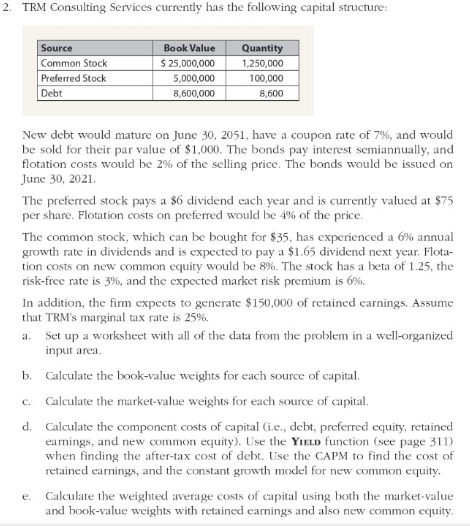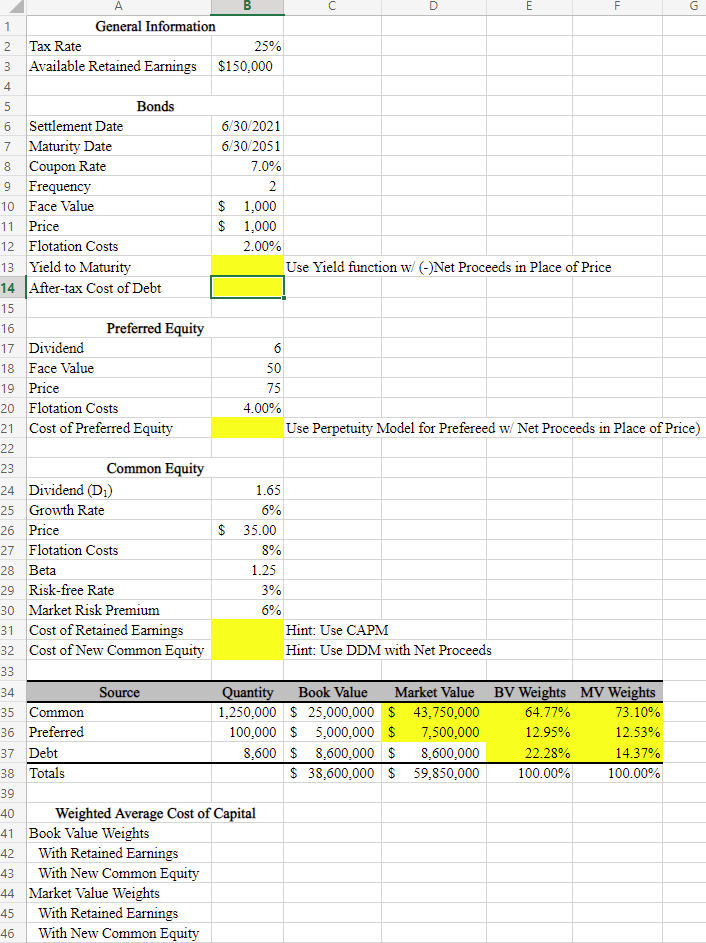TRM Consulting Services currently has the following capital structure: Source Book Value Quantity Common Stock Preferred Stock $ 25,000,000 1,250,000 5,000,000 100,000 Debt 8,600,000 8,600 New debt would mature on June 30, 2051, have a coupon rate of 7%, and would be sold for their par value of $1,000. The bonds pay interest semiannually, and flotation costs would be 2% of the selling price. The bonds would be issued on June 30, 2021. The preferred stock pays a $6 dividend each year and is currently valued at $75 per share. Flotation costs on preferred would be 4% of the price. The common stock, which can be bought for $35, has experienced a 6% annual growth rate in dividends and is expected to pay a $1.65 dividend next year. Flota- tion costs on new common equity would be 8%. The stock has a beta of 1.25, the risk-free rate is 3%, and the expected market risk premium is 6%. In addition, the firm expects to generate $150,000 of retaincd carnings. Assume that TRM's marginal tax rate is 25%. Set up a worksheet with all of the data from the problem in a well-organized input area. a. b. Calculate the book-value weights for each source of capital. c. Calculate the market-value weights for each source of capital. d. Calculate the component costs of capital (i.e., debt, preferred equity, retained earnings, and new common equity). Use the YIELD function (see page 311) when finding the after-tax cost of debt. Use the CAPM to find the cost of retained carnings, and the constant growth model for new common equity. e. Calculate the weighted average costs of capital using both the market-value and book-value weights with retained earnings and also new common equity.
TRM Consulting Services currently has the following capital structure: Source Book Value Quantity Common Stock Preferred Stock $ 25,000,000 1,250,000 5,000,000 100,000 Debt 8,600,000 8,600 New debt would mature on June 30, 2051, have a coupon rate of 7%, and would be sold for their par value of $1,000. The bonds pay interest semiannually, and flotation costs would be 2% of the selling price. The bonds would be issued on June 30, 2021. The preferred stock pays a $6 dividend each year and is currently valued at $75 per share. Flotation costs on preferred would be 4% of the price. The common stock, which can be bought for $35, has experienced a 6% annual growth rate in dividends and is expected to pay a $1.65 dividend next year. Flota- tion costs on new common equity would be 8%. The stock has a beta of 1.25, the risk-free rate is 3%, and the expected market risk premium is 6%. In addition, the firm expects to generate $150,000 of retaincd carnings. Assume that TRM's marginal tax rate is 25%. Set up a worksheet with all of the data from the problem in a well-organized input area. a. b. Calculate the book-value weights for each source of capital. c. Calculate the market-value weights for each source of capital. d. Calculate the component costs of capital (i.e., debt, preferred equity, retained earnings, and new common equity). Use the YIELD function (see page 311) when finding the after-tax cost of debt. Use the CAPM to find the cost of retained carnings, and the constant growth model for new common equity. e. Calculate the weighted average costs of capital using both the market-value and book-value weights with retained earnings and also new common equity.
Chapter12: The Cost Of Capital
Section: Chapter Questions
Problem 17P
Related questions
Question
I need D and E.

Transcribed Image Text:2. TRM Consulting Services currently has the following capital structure:
Source
Book Value
Quantity
Common Stock
$ 25,000,000
1,250,000
Preferred Stock
5,000,000
100,000
Debt
8,600,000
8,600
New debt would mature on June 30, 2051, have a coupon rate of 7%, and would
be sold for their par value of $1,000. The bonds pay interest semiannually, and
flotation costs would be 2% of the selling price. The bonds would be issued on
June 30, 2021.
The preferred stock pays a $6 dividend each year and is currently valued at $75
per share. Flotation costs on preferred would be 4% of the price.
The common stock, which can be bought for $35, has experienced a 6% annual
growth rate in dividends and is expected to pay a $1.65 dividend next year. Flota-
tion costs on new common equity would be 8%. The stock has a beta of 1.25, the
risk-free rate is 3%, and the expected market risk premium is 6%.
In addition, the firm expects to generate $150,000 of retaincd carnings. Assume
that TRM's marginal tax rate is 25%.
Set up a worksheet with all of the data from the problem in a well-organized
input area.
a.
b. Calculate the book-valuc weights for cach source of capital.
Calculate the market-value weights for each source of capital.
C.
d. Calculate the component costs of capital (i.e., debt, preferred equity, retained
earnings, and new common equity). Use the YIELD function (see page 311)
when finding the after-tax cost of debt. Use the CAPM to find the cost of
retained earnings, and the constant growth model for new common equity.
e. Calculate the weighted average costs of capital using both the market-value
and book-value weights with retained carnings and also new common equity.

Transcribed Image Text:D
E
F
1
General Information
Tax Rate
25%
Available Retained Earnings $150,000
5
Bonds
6.
Settlement Date
6/30/2021
Maturity Date
Coupon Rate
Frequency
7
6/30/2051
8.
7.0%
9.
2
$ 1,000
$ 1,000
10 Face Value
11 Price
12 Flotation Costs
2.00%
13 Yield to Maturity
14 After-tax Cost of Debt
Use Yield function w/ (-)Net Proceeds in Place of Price
15
16
Preferred Equity
17 Dividend
6
18 Face Value
50
19 Price
75
20 Flotation Costs
4.00%
21 Cost of Preferred Equity
Use Perpetuity Model for Prefereed w/ Net Proceeds in Place of Price)
22
23
Common Equity
24 Dividend (D1)
1.65
25 Growth Rate
6%
26 Price
$ 35.00
27 Flotation Costs
8%
28 Beta
1.25
29 Risk-free Rate
3%
30 Market Risk Premium
6%
31 Cost of Retained Earnings
32 Cost of New Common Equity
Hint: Use CAPM
Hint: Use DDM with Net Proceeds
33
Source
Book Value
Market Value BV Weights MV Weights
Quantity
1,250,000 $ 25,000,000 $ 43,750,000
100,000 $ 5,000,000 $
8,600 $ 8,600,000 $
34
35 Common
64.77%
73.10%
36 Preferred
7,500,000
12.95%
12.53%
37 Debt
8,600,000
$ 38,600,000 $ 59,850,000
22.28%
14.37%
38 Totals
100.00%
100.00%
39
40
Weighted Average Cost of Capital
Book Value Weights
With Retained Earnings
41
42
43
With New Common Equity
44 Market Value Weights
With Retained Earnings
45
46
With New Common Equity
Expert Solution
This question has been solved!
Explore an expertly crafted, step-by-step solution for a thorough understanding of key concepts.
This is a popular solution!
Trending now
This is a popular solution!
Step by step
Solved in 2 steps with 7 images

Knowledge Booster
Learn more about
Need a deep-dive on the concept behind this application? Look no further. Learn more about this topic, finance and related others by exploring similar questions and additional content below.Recommended textbooks for you

EBK CONTEMPORARY FINANCIAL MANAGEMENT
Finance
ISBN:
9781337514835
Author:
MOYER
Publisher:
CENGAGE LEARNING - CONSIGNMENT

Fundamentals Of Financial Management, Concise Edi…
Finance
ISBN:
9781337902571
Author:
Eugene F. Brigham, Joel F. Houston
Publisher:
Cengage Learning


EBK CONTEMPORARY FINANCIAL MANAGEMENT
Finance
ISBN:
9781337514835
Author:
MOYER
Publisher:
CENGAGE LEARNING - CONSIGNMENT

Fundamentals Of Financial Management, Concise Edi…
Finance
ISBN:
9781337902571
Author:
Eugene F. Brigham, Joel F. Houston
Publisher:
Cengage Learning



Financial Reporting, Financial Statement Analysis…
Finance
ISBN:
9781285190907
Author:
James M. Wahlen, Stephen P. Baginski, Mark Bradshaw
Publisher:
Cengage Learning

Intermediate Financial Management (MindTap Course…
Finance
ISBN:
9781337395083
Author:
Eugene F. Brigham, Phillip R. Daves
Publisher:
Cengage Learning